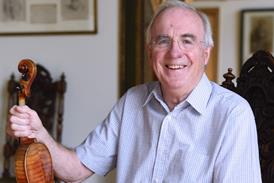In the August 2021 issue, Joseph Curtin examines the evolution of neck setting. Twelve years ago he looked into a violin’s acoustic behaviours, and how its signature ‘modes’ indicate its sound and response

This extract is taken from the article ’Violin modal analysis – part one: Scent of a violin’ which appeared in the June 2009 issue. To read the full article, click here
A perfume, like a violin, is designed to evoke an emotional response. Though the response may vary wildly from one person to the next, the perfume itself can be fully characterised by the essential oils from which it is made. Provided these are known, the perfume – along with its effects on any given individual – can be replicated perfectly. Similarly, the acoustic behaviour of a violin is characterised by a set of resonances known as its normal modes of vibration.
Together, these describe how all parts of the instrument move at all frequencies, how the whole instrument interacts with the bowed string, and how much sound is radiated in each direction. This modal viewpoint has obvious research implications, but it also has a particular relevance to violin makers: you don’t need to know why a given combination of modes yields the sound and response of an old Italian violin, only that if a new violin is to have an identical sound and response, it must also have identical modes.
Unfortunately, makers can’t mix and match normal modes the way perfume makers mix and match essential oils. Rather, the modes are the end result of decisions made about everything from the wood to the graduation to the set-up. The complexity, variability and interconnection of these factors limit the possibilities for manipulating modes individually. Maker and researcher Martin Schleske tested the practical limits of such manipulation with his ‘tonal copies’ of old Italian violins.
Cambridge scientist Jim Woodhouse explored both the practical and theoretical limits in his paper Body vibration of the violin – what can a maker expect to control?
Any normally built violin has, at the low end of its frequency range, five readily identifiable modes – often referred to as its signature modes. Typically, only three of them are capable of radiating significant amounts of sound. The lowest of these is known as A0 (pronounced ‘A-zero’). It will be the focus of this article. The other two, B1- and B1+ (B-one-minus, B-one-plus), will be discussed next month.
There are several reasons why violin makers should pay attention to these three modes. Most obviously, they are responsible for virtually all the sound output below the frequency of the open E string (660Hz). They are also useful as norms or indicators. For example, if you want to emulate the ‘old Italian sound’, it makes sense to keep your mode frequencies within an ‘old Italian range’ – whatever that may be. More specifically, if the modes of a copy differ significantly from those of the original, then there must also be significant structural or material differences. These can sometimes be addressed by adjusting or reworking the copy, and sometimes only by choosing more appropriate wood for the next copy.



































No comments yet